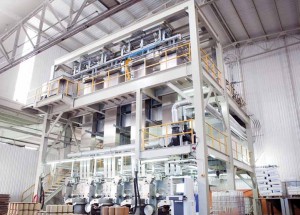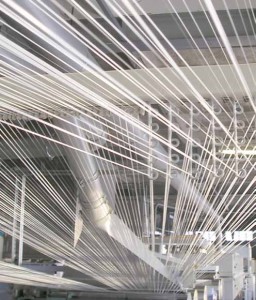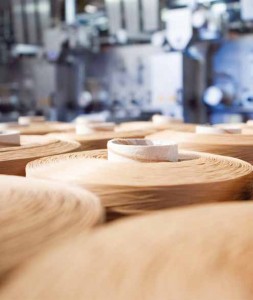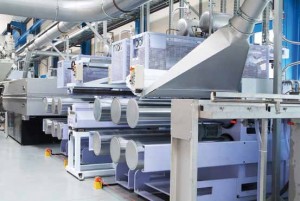By Christina Mallin / Jens Weinhold
Oerlikon Neumag is the market leader for BCF carpet yarn systems so essential for modern carpet manufacturing. However, the fact that the backing of wall-to-wall carpeting and rugs is manufactured within the Oerlikon Manmade Fibers Business Unit will undoubtedly come as a surprise to most carpet producers: carpet backing is manufactured using Oerlikon Barmag extrusion systems.
Carpets for residential, contract and automotive applications mostly comprise a backing material, a tufted or woven pile material and a binder coating. The pile material is manufactured using BCF systems from Oerlikon Neumag. Extrusion systems from the Chemnitz-based subsidiary of Oerlikon Barmag take care of the backing fabric along with the pile material for products used in various sports, such as monofilaments or tapes used to manufacture artificial turf.
Bulked continuous filament
 Today, 88 per cent of all carpet yarn is made from chemical raw materials, which are polypropylene, polyamide and polyester. Manufacturing carpet yarn can be carried out either by using filament yarn or spun yarns, the latter of which is made from chemical staple fibers – possibly also produced on Neumag staple fiber machines – and is generally combined with natural fibers.
Today, 88 per cent of all carpet yarn is made from chemical raw materials, which are polypropylene, polyamide and polyester. Manufacturing carpet yarn can be carried out either by using filament yarn or spun yarns, the latter of which is made from chemical staple fibers – possibly also produced on Neumag staple fiber machines – and is generally combined with natural fibers.
Spinning filament yarn has firmly established itself as the preferred method for manufacturing carpet yarn: it is less expensive to manufacture, the carpet is lower in maintenance, robust and more hypoallergenic. To produce filament yarn, the polymer is melted in an extruder and pressed through spinnerets. In the case of spun-dyed yarn, dye is added prior to extrusion using a metering unit.
 Following the spinning system, the filament bundle – which generally comprises 144 individual filaments and has a total titer of between 1000 and 3000 dtex – is drawn with the help of godets.
Following the spinning system, the filament bundle – which generally comprises 144 individual filaments and has a total titer of between 1000 and 3000 dtex – is drawn with the help of godets.
This creates a strong and extremely thin filament material. In the subsequent process step, the yarn is textured and cooled on a cooling drum. In this way, it retains the properties required to further process it into carpeting – volume and bulkiness – and it is transformed from smooth filament yarn into textured endless yarn (bulked continuous yarn – BCF).
Subsequently, the yarns are knotted using a tangle unit to retain the textured multifilament for downstream processes and then wound. The winding speed, which is dependent on the polymer and the titer, is 3,000 meters per minute for a standard polypropylene yarn.
The BCF carpet yarn systems in Oerlikon Neumag’s product portfolio are the S5, the S3, the Sytec One and the S+. Each of them is adapted to the specific requirements of various customers. The S5, S3 and S+ are three-end systems, while the single-end Sytec One is particularly flexible.
Carpet backing
 In the case of the backing material, we distinguish between primary and secondary backing; an additional product group is woven carpet yarns. Tapes for primary and secondary backing are manufactured on extrusion systems such as the FB9 filament tape line from Oerlikon Barmag, the market leader within this product segment.
In the case of the backing material, we distinguish between primary and secondary backing; an additional product group is woven carpet yarns. Tapes for primary and secondary backing are manufactured on extrusion systems such as the FB9 filament tape line from Oerlikon Barmag, the market leader within this product segment.
The primary backing is the woven surface into which the carpet fibers are needled during tufting. It comprises the warp (approx. 0.9 mm wide) and weft (approx. 2.5 mm wide).
The secondary backing is the textile surface, which is laminated on the reverse to provide the carpet with the necessary stability. For this, the warp tapes are combined with an air-textured multifilament weft to lend the final product its textile touch.
What is important for the backing material during tufting is a low degree of tape shrinkage and consistent elongation. These properties are achieved through extending the contact time between the tapes and the heated godets.
The optimization of the contact time and the wrapping angle has a positive impact on the process speed and the energy consumption. Up to 700 (warp) tapes are simultaneously manufactured using one single system, and their properties must lie within extremely narrow tolerance thresholds.
 The tapes are first fibrillated by means of 30 to 40 needles per centimeter to ensure that the tufting needles find a path through the tapes and are then wound into packages.
The tapes are first fibrillated by means of 30 to 40 needles per centimeter to ensure that the tufting needles find a path through the tapes and are then wound into packages.
The backing fabric is manufactured from the warp and weft during a further interim step for the warp tapes, where four- or five-meter-wide loom beams are created in the beam plant.
The traditional jute used to make the backing for woven carpets is reproducibly replicated using polypropylene tapes comprising a combination of the lowest rate of shrinkage and lower elongation. Packages manufactured with flat, fibrillated tapes using the extrusion system are subsequently transformed into round, textile filaments with the help of a twisting machine such as the DD2000, for example. It is later introduced directly to the double carpet weaving machine, as this process does not use a backing fabric as in the case of tufting.
The carpet backing material of choice is generally polypropylene. However, there is an increasing focus on substituting this with polyester. Polyester has outstanding properties in terms of thermal stability and dimensional stability under load. Furthermore, polyester excels both with its currently attractive price compared to polypropylene and with its potential recycling capacity. In this age of intensive sustainability discussion, this is a factor very much worthy of consideration.